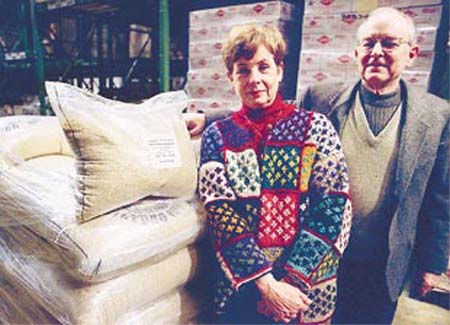
Ecuador RPCVs Bob and Marjorie Leventry make Quinoa Soup
Quinoa Soup
A traditional staple of the high, cool Andes
by Corby Kummer
.....
I recently watched a scene of ancient beauty in the Andean highlands of Ecuador: women reaching skyward to pour just-threshed quinoa from shallow baskets onto blankets, so that the wind would winnow the wide streams of falling grain. They knelt to gather up the grain back into their baskets, and then let it fall once more before they set it aside in a pile.
I had traveled four hours south of Quito on bumpy, spectacularly scenic roads to see at close hand the harvest of a grain I ate ten or so years ago, when chefs eager to use a "new" native crop embraced quinoa (pronounced keen-wah) as part of their New American cooking. The tiny, straw-yellow kernels, which look like plumped sesame seeds, occupied a place that had recently been held by hand-gathered wild rice and was soon to be taken by amaranth. (Today the novelty starch is Israeli couscous, pasta beads as big as giant tapioca.)
I never warmed to amaranth, but I did develop a taste for quinoa. It has some of the nutty flavor of wild rice but a less challenging texture, with a moment of caviar crunch before each bite becomes a pliant mouthful. It's pretty, too: each grain has a pearlescent halo, which turns out to be the extremely nutritious germ. Quinoa became my second favorite novelty grain after buckwheat (with its matchless toasted heartiness), but after a few home experiments I forgot about it. Then I learned of a newly available organic quinoa not only more environmentally responsible but also better than any I'd tasted. This was the quinoa I saw being winnowed on that volcanic hillside, where the sky seemed very close.
My guide was the importer, a Chicagoan named Bob Leventry, who had served for two years in Ecuador as a Peace Corps volunteer with his wife, Marjorie, a nutritionist, after retiring as the head of an insurance company. They wanted to carry on the work they had done there, and looked for a way to help the Andean farmers they saw being cheated by middlemen; they also wanted to further the cause of organic farming.
The couple found a group of farmers within broadcast range of ERPE, a progressive radio station based in the lively provincial capital of Riobamba. In the early 1960s an activist monsignor had founded the station to teach literacy and basic subjects to indigenous populations; it also aired music, of course, and lots of local interviews and news. In the 1980s ERPE became an independent nonprofit station with a wider social-service agenda. It broadcast lessons in modern organic-farming techniques, for example, and invited listeners to visit a model farm where ERPE grew, among other native crops, quinoa.
Bob Leventry promised ERPE that his new company, Inca Organics, would sell all the quinoa ERPE's listeners could grow. In just a few years they have had remarkable success, and not simply because Marjorie persuasively emphasizes what a nutritional powerhouse quinoa is. (Quinoa is not a true grain but the seed of a leafy plant; unlike grains, which lack at least one essential amino acid, it offers a complete source of protein, and because it is unrelated to wheat, people sensitive to gluten can eat it.) The company has succeeded because Inca Organics quinoa is cleaner, fresher, sweeter, and livelier tasting than the kind most health-food markets sell. (The Web site, www.IncaOrganics.com, gives links to mail-order sources and stores that stock it; the phone number is 312-575-9880.)
The Ecuadorian farmers have benefited too. In 1997, the first year of the ERPE quinoa experiment, 220 families took part; last year 4,025 families grew quinoa for Inca Organics. Each family keeps one third of its production for its own use. Last month ERPE received the Slow Food Award for biodiversity at a ceremony in Turin, for its pioneering combination of radio and on-site farming help.
When the day's work was finished, the Mocha Pingos, the farm family I visited, served us a soup—a staple in the high, cool Andes. The family soup was nearly clear, a pale orange with bright orange flecks of achiote, or annatto seed, sautéed in lard to concentrate and mellow its slightly peppery flavor. I've adapted a recipe from Marjorie Leventry, who for ease uses cumin and paprika where the family would use achiote; in Soup: A Way of Life, Barbara Kafka gives instructions for annatto butter, a primary component of the fantastic variety of Ecuadorian soups she discovered.
For four servings of traditional quinoa soup, heat one tablespoon of oil in a large saucepan over medium heat. Sauté in the warm oil half a cup of chopped green onion, keeping an inch of the green, or yellow onion; three garlic cloves, smashed, peeled, and chopped; half a teaspoon each of cumin and paprika (or one tablespoon of Kafka's annatto butter); and half a teaspoon of dried oregano. Stir for five minutes or so, until the onion is thoroughly wilted. Add half a cup of well-rinsed quinoa, five and a half cups of water, one teaspoon of kosher salt, half a pound of peeled floury (baking) potatoes cut into half-inch cubes, and a cup of chopped cabbage or any hearty greens. Cover and bring to a boil. Reduce the heat and simmer for twenty minutes, or until the potatoes are soft. Stir in a tablespoon of minced cilantro and serve.
This simple soup is surprisingly satisfying. Optional stir-in ingredients, of the kind at markets and soup stands in Ecuador, include ground roasted peanuts, diced avocado, and crumbled fresh cheese similar to Mexican queso blanco. I won't give directions for the special ingredient the family put in our soup as a sign of respect for visitors: guinea pig, the Ecuadorian answer to chicken. Some native traditions translate better than others.
